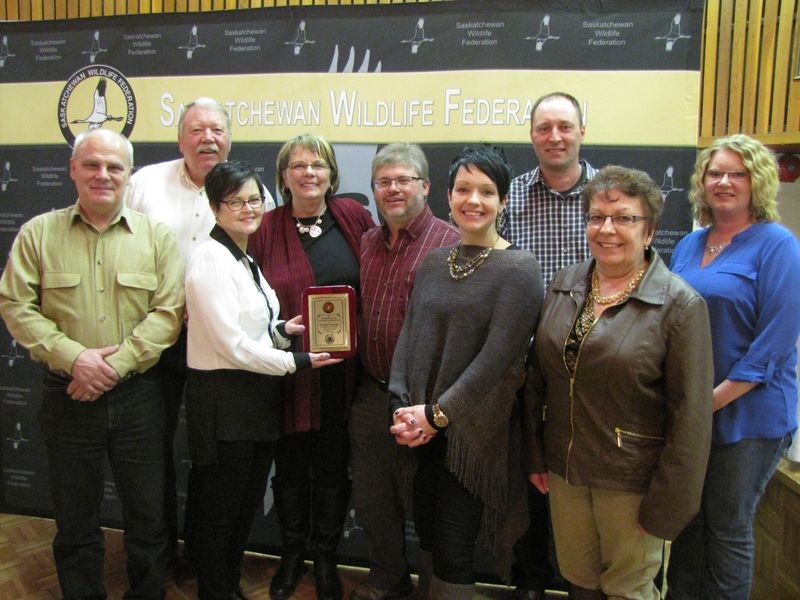The River Ridge branch of the Saskatchewan Wildlife Federation received a plaque in recognition of $40,000 being donated for the Habitat Trust program.
While Kathy Thomas, the branch president, received the plaque, it was the whole River Ridge delegation that was photographed with the plaque. The delegation included: Hal and Kathy Thomas, Kerry and Liz Perepeluk, Robin and Rheta Ludba, Damon and Naomi Paley, and Lee-Anne Butterfield.
Having the convention in Yorkton this year made it a little easier for more delegates to attend, said Thomas. In total, there were 225 voting delegates from across the province.
Attending the provincial convention is always good to gain new insight into matters affecting wildlife and hunters and fishermen, she said.
It was interesting to note that the SWF took over operation of the fish hatchery at Fort Qu’Appelle and last year, the hatchery produced 12,133,635 fry that were stocked in 169 lakes across the province, Thomas said.
Despite the number of new cases of chronic wasting disease (CWD) being very low in recent years, hunters and the SWF need to remain vigilant in tracking the disease, and perhaps, come up with a new management plan, she said. Speakers on the subject said it’s virtually impossible to have no CWD in the wild as the prion which causes the disease is found in plants. It seems that mule deer are the most susceptible to the disease while moose are the least susceptible.
Since the 2015 hunting season, the provincial lab has tested 21 mule deer and four white-tailed deer and only one mule deer tested positive for CWD, Thomas said.
A warning was sounded because of the growing feral boar population, she said. It is assumed the original wild boars escaped from wild boar farms, but because the species reproduces so quickly, it is quickly becoming a very destructive species with few predators.
These highly adaptable animals grow to from 75 pounds to 350 pounds in Saskatchewan, Thomas said. The Ministry of Agriculture deems feral boars to be stray livestock and a pest species. The ministry has no plans to stop wild boar farms.
One method of trying to control the growing population was a concentrated effort by hunters, but their efforts reduced the population by only eight to 24 per cent, she said. Speakers argued that is necessary to cull 65 to 70 per cent just to stabilize the population.
Another problem species is zebra muscles which are just entering Saskatchewan, Thomas said. It was disappointing to hear that the provincial government has no strategy to keep them out. In extreme cases, zebra muscles can plug waterways.
The River Ridge SWF branch will be holding its 27th annual banquet and awards night on Saturday at the Rainbow Hall.



.png;w=120;h=80;mode=crop)
